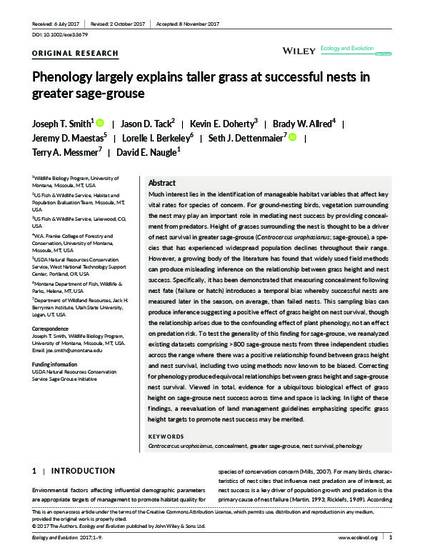
Article
Phenology largely explains taller grass at successful nests in greater sage-grouse
Ecology and Evolution
(2017)
Abstract
Much interest lies in the identification of manageable habitat variables that affect key vital rates for species of concern. For ground-nesting birds, vegetation surrounding the nest may play an important role in mediating nest success by providing concealment from predators. Height of grasses surrounding the nest is thought to be a driver of nest survival in greater sage-grouse (Centrocercus urophasianus; sage-grouse), a species that has experienced widespread population declines throughout their range. However, a growing body of the literature has found that widely used field methods can produce misleading inference on the relationship between grass height and nest success. Specifically, it has been demonstrated that measuring concealment following nest fate (failure or hatch) introduces a temporal bias whereby successful nests are measured later in the season, on average, than failed nests. This sampling bias can produce inference suggesting a positive effect of grass height on nest survival, though the relationship arises due to the confounding effect of plant phenology, not an effect on predation risk. To test the generality of this finding for sage-grouse, we reanalyzed existing datasets comprising >800 sage-grouse nests from three independent studies across the range where there was a positive relationship found between grass height and nest survival, including two using methods now known to be biased. Correcting for phenology produced equivocal relationships between grass height and sage-grouse nest survival. Viewed in total, evidence for a ubiquitous biological effect of grass height on sage-grouse nest success across time and space is lacking. In light of these findings, a reevaluation of land management guidelines
Disciplines
Publication Date
2017
DOI
DOI: 10.1002/ece3.3679
Citation Information
Terry A. Messmer. "Phenology largely explains taller grass at successful nests in greater sage-grouse" Ecology and Evolution Vol. 2017 (2017) p. 1 - 9 Available at: http://works.bepress.com/terry-messmer/368/
